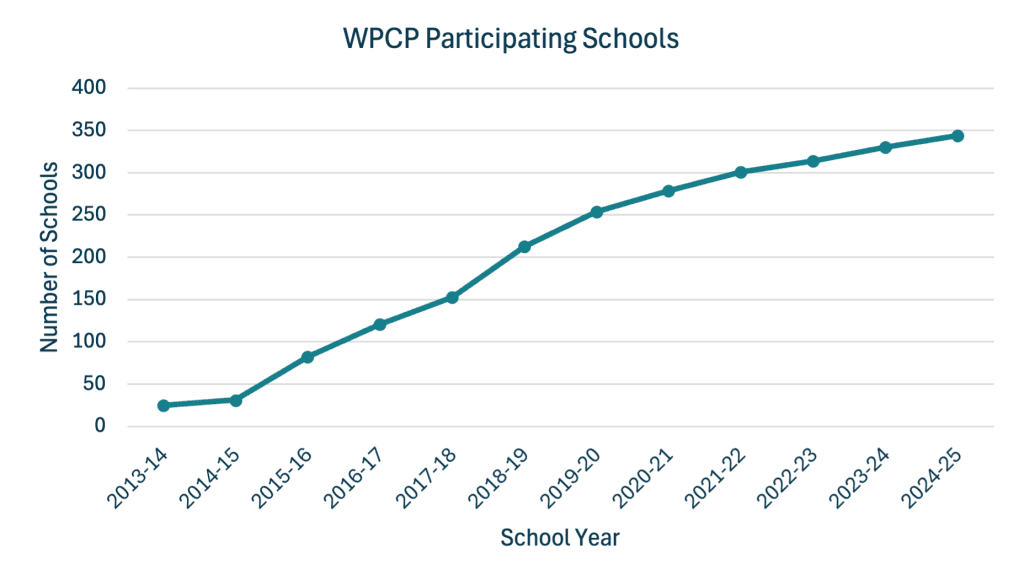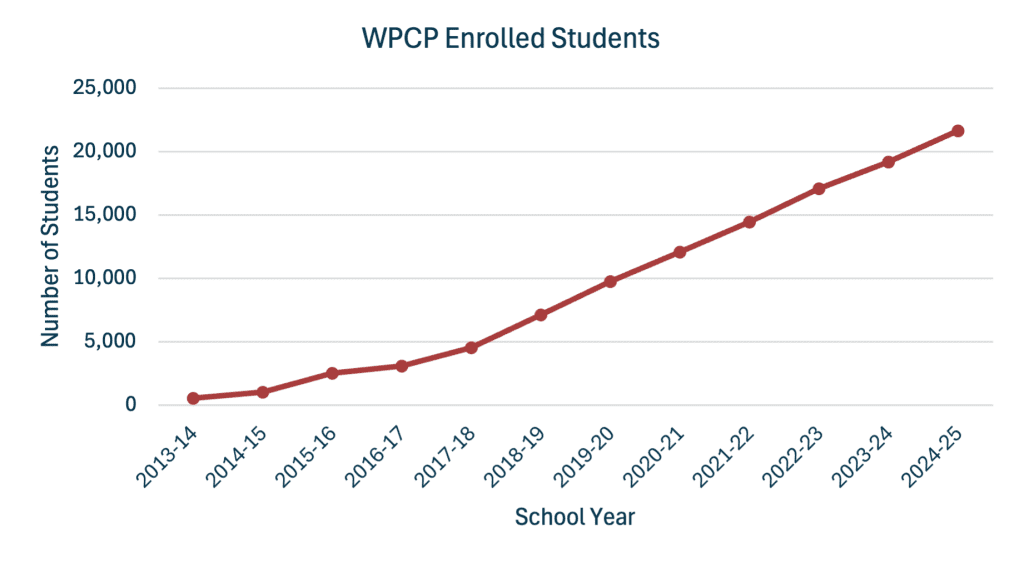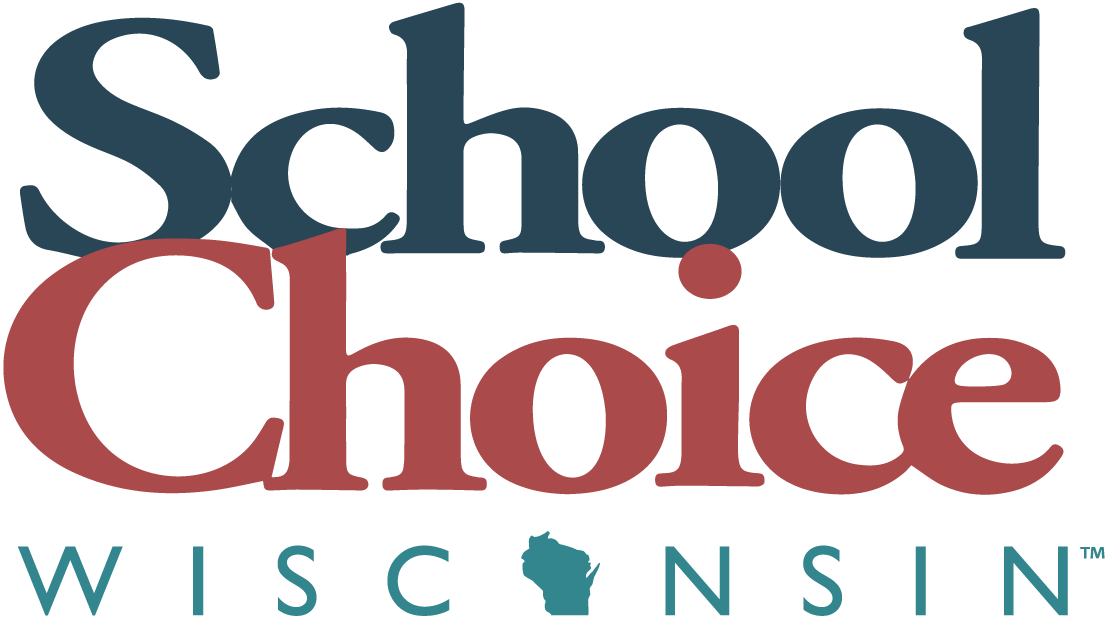Wisconsin Parental Choice Program
Wisconsin Parental Choice Program
357 Choice Schools |
23,417 Participating Students |
The Wisconsin Parental Choice Program (WPCP), a statewide private school voucher program, was enacted and launched in 2013. The program allows students whose families meet certain income qualifications and are not assigned to the Milwaukee Public Schools or Racine Unified school districts the ability to attend a participating private or religious school of their choice, tuition free.
WPCP Student Eligibility
- The student must reside in Wisconsin and outside the city of Milwaukee and Racine Unified School District.
- Family income must be at or below 220% of the federal poverty level.
- The student must meet one of the following prior year attendance requirements: a public school student in grades K4-12; a student who was not enrolled in school the previous year including attending a homeschool; a private school student in grades K4, K5, 1, 9; and a student who participated in the MPCP or RPCP the previous school year.
WPCP Voucher Amounts
For the 2025–2026 school year, the amount of the voucher is $10,877 for grades K-8 and $13,371 for grades 9-12. The voucher amount increases by an amount equal to the increase in state public school funding each year.
Wisconsin Parental Choice Program FAQ
Some schools accept the supporting documentation via email. Contact the school directly regarding how to provide the supporting documentation or check their website.
Schools are permitted to charge additional fees for the following things:
- Personal items such as towels, gym clothes or uniforms
- Social and extracurricular activities not a part of the required curriculum
- Musical instruments
- Meals
- Transportation
- Before and after-school care
- High school classes not required for graduation
In grades K-8, the voucher is accepted as full payment for the cost of tuition. In grades 9-12, the school may charge additional tuition if the family’s income is greater than 220 percent of the federal poverty level.
If you don’t want your child to participate in religious activity or religious instruction, simply notify the child’s teacher or the school principal in writing.
All students who meet residency, prior year attendance, and income requirements are eligible for the program. A school may not use grades or test scores as a condition of acceptance. A school may test students for placement purposes after they’ve been accepted.
You need complete the online application each year during the open enrollment period. Open enrollment periods vary by choice program.
The application is on the DPI website and you must have an email address to use the system. If your student doesn’t meet the application grade level or prior year attendance requirement, you won’t be able to complete the application.
You may apply to one or more schools at the same time.
Eligibility is based on family income, prior year attendance, residency, and age of students entering grades K4, K5, and 1. Eligibility is not based on race, ethnic background, religion, prior test scores, grades, recommendations or membership in a church or parish. Choice schools must accept all eligible applications.
In the RPCP, MPCP, and WPCP, the school must have a random drawing to select choice students if there are more eligible applications submitted than seats available.
It depends on the school and on the school district. Some schools provide transportation. Some districts provide transportation or reimburse the parent a certain amount for their transportation costs. Check directly with the school you plan to attend or with your district of residence.
Wisconsin is home to four parental choice programs – the Milwaukee Parental Choice Program (MPCP), the Racine Parental Choice Program (RPCP), the Wisconsin Parental Choice Program (WPCP), and the Special Needs Scholarship Program (SNSP).
The school will notify you within 60 days whether your child has received a voucher or has been placed on a waiting list. If more applications are received than slots available, the school will also let you know the date of the lottery to select choice students. If your student is placed on the waiting list, the school will let you know what your place in line is. If the school rejects your application, the notice of non-acceptance will give you the reason why.
If your student is offered a choice seat, you must notify the school within five days whether or not they will attend. You must also provide proof of residency and income before the end of the enrollment period.
The “once in, always in” provision means your child keeps his or her voucher even if family income rises, as long as your student continues to attend a choice school and does not voluntarily leave the program. Your family might have some children who qualify and others that don’t depending on the year each one applies to enter one of the Wisconsin school choice programs.
Wisconsin Parental Choice Program Growth


WPCP Timeline
2013
WPCP IS LAUNCHED
The first year enrollment cap was 500 students.
2014
YEAR 2
The enrollment cap increases to 1000 students with no more than 1% of the students of any school district enrolled at a time.
2015
YEARS 3 – 5
The total number of students enrollment cap is eliminated. From 2015– 2017, the WPCP enrollment cap for each district was 1% of the district’s prior year total enrollment.
2016
VOUCHER INCREASES
Per-pupil increases for public schools and voucher schools are linked dollar for dollar.
2017
YEAR 6
Beginning this year, the enrollment cap for each district increases 1% per year. Once it reaches 10%, there will be no enrollment cap for individual districts in the statewide program.
2018
ACT TEST PERFORMANCE
WPCP students earned an average of 21.0 out of 36 points on the ACT Exam, compared to Wisconsin students as a whole who earned a score of 19.8 out of 36.
2022
17,079 PARTICIPATING STUDENTS
2023
VOUCHER INCREASES
State legislators from both sides of the political aisle came together with the Governor to make historic increases to per pupil payment amounts.
2025
23,417 PARTICIPATING STUDENTS
 Skip to content
Skip to content